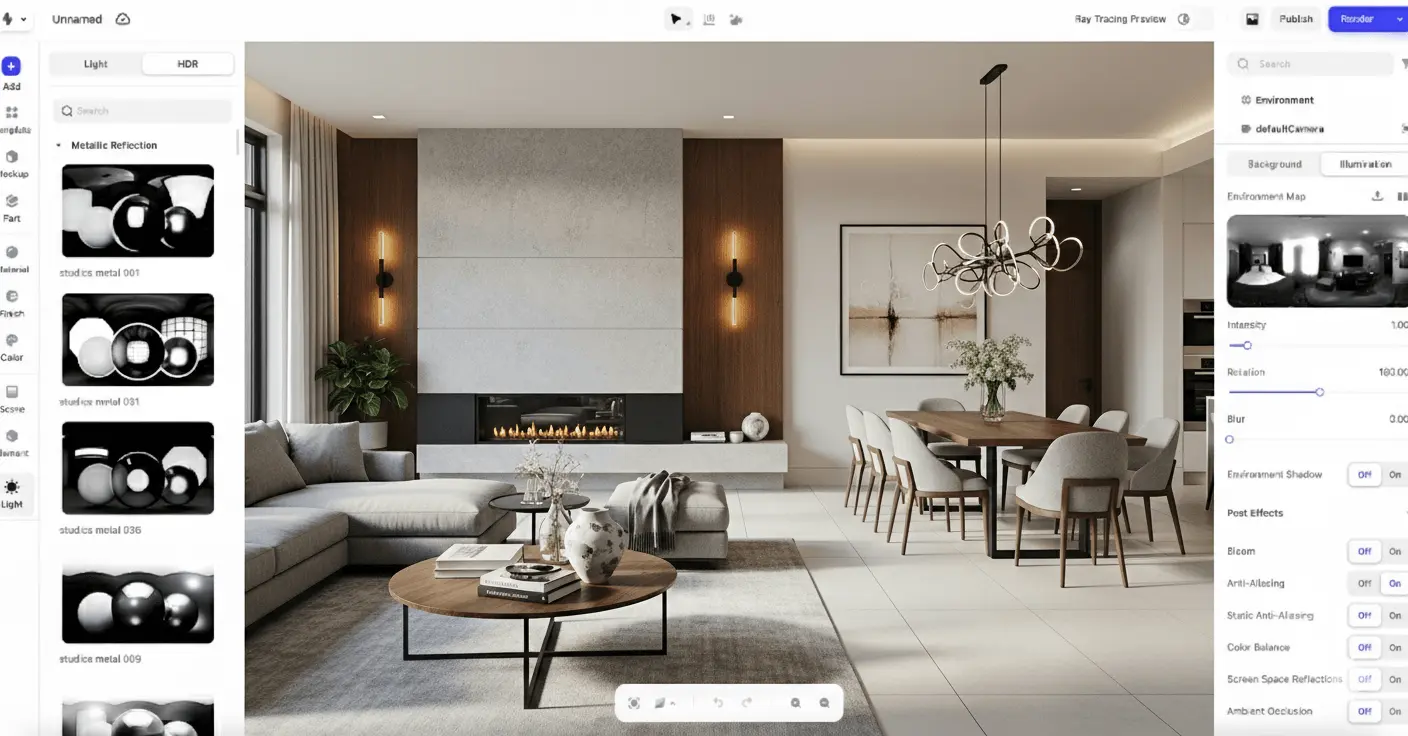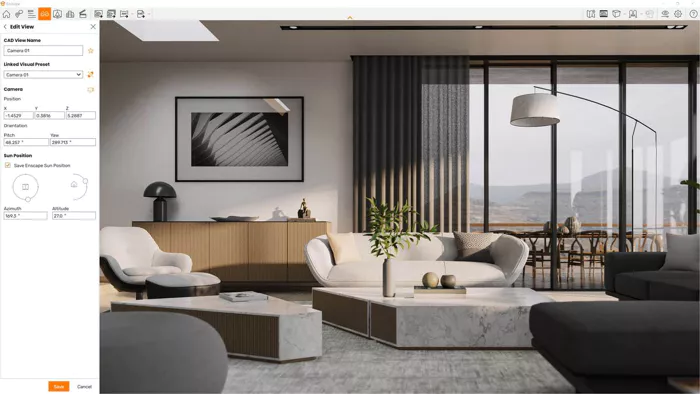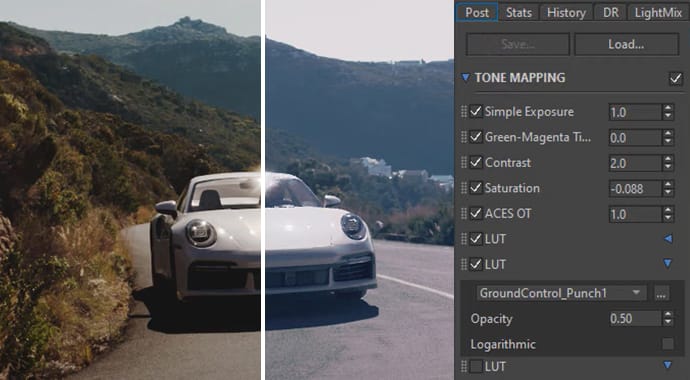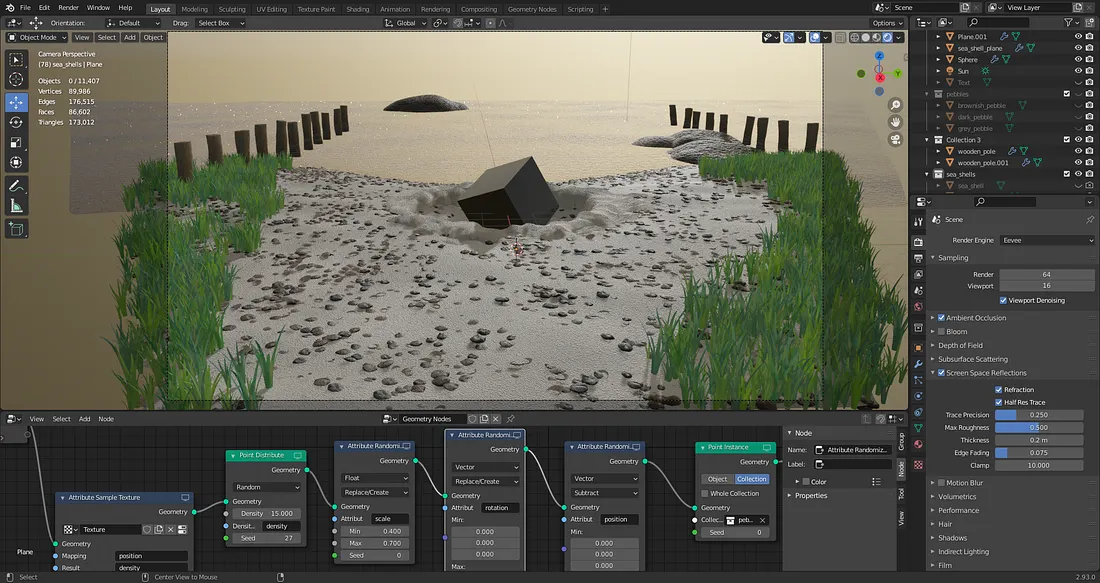The greatest challenge for any interior designer isn't just creating a beautiful space—it's helping the client see it. Floor plans are flat, mood boards are abstract. They require a leap of faith that many clients struggle to make.
3D rendering software for interior design is the bridge across that gap. It transforms concepts into tangible, photorealistic experiences, replacing guesswork with the confidence that drives decisive approvals. But with a dizzying array of options, which tool is truly right for your practice?
As a designer who has spent years in the trenches with these platforms, I've curated this definitive guide. We'll cut through the marketing noise to focus on the nine most effective rendering solutions that will elevate your designs and streamline your workflow.
The 9 Best 3D Rendering Software for Interior Design
Our analysis evaluates each platform's strengths in realism, workflow integration, asset libraries, and its strategic fit for different design practice requirements.
1. Realishot - The Collaborative Cloud-Native Design Studio
While most software focuses on the final render, Realishot redefines the entire interior design workflow. It’s a complete, browser-based studio designed to solve the modern challenges of collaboration, asset management, and client communication, making it more than a renderer—it's a practice management tool.
Instead of a siloed desktop application, Realishot provides a centralized hub where your team, your assets, and your clients can converge. It transforms a linear, friction-filled process into a fluid, interactive dialogue.
 realishot-interior-rendering
realishot-interior-rendering
 My Experience: The first time a client left a comment directly on a 3D model of a sofa in their web browser—no software, no downloads, just a link—I knew the game had changed. The traditional, week-long cycle of exporting, emailing, and deciphering feedback was crushed into a 15-minute conversation.
My Experience: The first time a client left a comment directly on a 3D model of a sofa in their web browser—no software, no downloads, just a link—I knew the game had changed. The traditional, week-long cycle of exporting, emailing, and deciphering feedback was crushed into a 15-minute conversation. What Makes It Different: Its AI isn't a gimmick. It acts like a junior assistant, setting up baseline lighting so you're not starting from a black void, which lets you get to the art of lighting faster. The Figma integration is another revelation. I watched our graphic designer drag a new fabric pattern into Figma, and it appeared on the 3D sofa in my browser seconds later. That single feature saved an hour of tedious UV mapping.
What Makes It Different: Its AI isn't a gimmick. It acts like a junior assistant, setting up baseline lighting so you're not starting from a black void, which lets you get to the art of lighting faster. The Figma integration is another revelation. I watched our graphic designer drag a new fabric pattern into Figma, and it appeared on the 3D sofa in my browser seconds later. That single feature saved an hour of tedious UV mapping. Who It's For: Modern interior design firms of any size, especially those with remote teams or who want to offer their clients a truly premium, interactive, and transparent design experience.
Who It's For: Modern interior design firms of any size, especially those with remote teams or who want to offer their clients a truly premium, interactive, and transparent design experience. The Bottom Line: It's an accessible subscription (starting at $29/month) that pays for itself almost immediately by slashing revision time and eliminating the need for every designer to have a top-of-the-line workstation.
The Bottom Line: It's an accessible subscription (starting at $29/month) that pays for itself almost immediately by slashing revision time and eliminating the need for every designer to have a top-of-the-line workstation.
2. Enscape - The "Magic Window" into Your Design
Enscape feels like magic. It's not a program you export your model to; it's a live, photorealistic window that opens right inside your CAD software. You move a wall in SketchUp, and the change appears instantly in the stunningly rendered Enscape window.
 Enscape real-time rendering plugin interface
Enscape real-time rendering plugin interface
 My Experience: I use Enscape during the most intense phases of design development. It allows me to "inhabit" the space as I'm building it, catching awkward spatial relationships or poor lighting choices on the fly, long before they become costly mistakes.
My Experience: I use Enscape during the most intense phases of design development. It allows me to "inhabit" the space as I'm building it, catching awkward spatial relationships or poor lighting choices on the fly, long before they become costly mistakes. What Makes It Different: The sheer speed and immediacy of the live-link. It transforms rendering from a final, time-consuming step into an integral, interactive part of the creative process.
What Makes It Different: The sheer speed and immediacy of the live-link. It transforms rendering from a final, time-consuming step into an integral, interactive part of the creative process. Who It's For: Architects and interior designers who live inside BIM/CAD software like Revit or SketchUp and want instant, high-quality visual feedback without ever breaking their stride.
Who It's For: Architects and interior designers who live inside BIM/CAD software like Revit or SketchUp and want instant, high-quality visual feedback without ever breaking their stride. The Bottom Line: A professional subscription tool whose value isn't just in the final image, but in the countless hours it saves during the design and iteration phases.
The Bottom Line: A professional subscription tool whose value isn't just in the final image, but in the countless hours it saves during the design and iteration phases.
3. Twinmotion - The Cinematic Storyteller
Powered by the same Unreal Engine that creates breathtaking video games, Twinmotion is all about atmosphere and narrative. It doesn't just render a room; it helps you tell a story about it, complete with weather, seasons, and moving people.
-5z0zko.webp) Twinmotion real-time interior visualization software interface
Twinmotion real-time interior visualization software interface
 My Experience: When I need to sell not just a design but a mood, I turn to Twinmotion. Its Path Tracer can produce lighting that is astonishingly realistic, and the ability to quickly create a video walkthrough where rain gently falls outside the window is a presentation tool that never fails to impress.
My Experience: When I need to sell not just a design but a mood, I turn to Twinmotion. Its Path Tracer can produce lighting that is astonishingly realistic, and the ability to quickly create a video walkthrough where rain gently falls outside the window is a presentation tool that never fails to impress. What Makes It Different: Its game engine DNA. The quality of its real-time lighting and its vast library of animated assets (people, pets, vehicles) make scenes feel alive.
What Makes It Different: Its game engine DNA. The quality of its real-time lighting and its vast library of animated assets (people, pets, vehicles) make scenes feel alive. Who It's For: Designers who want to create emotive, cinematic presentations and immersive VR experiences that go beyond static images.
Who It's For: Designers who want to create emotive, cinematic presentations and immersive VR experiences that go beyond static images. The Bottom Line: Incredibly accessible. A generous free version and competitive pricing make it one of the best values in professional visualization.
The Bottom Line: Incredibly accessible. A generous free version and competitive pricing make it one of the best values in professional visualization.
4. Corona Renderer - The Artist's Choice for Photorealism
Corona is for the purists. It's a tool with a singular focus: to create the most beautiful, physically accurate, and clean interior renders possible, with an artist-friendly approach. It has a certain quiet confidence to it.
 Interior rendering created with Corona Renderer showing photorealistic lighting
Interior rendering created with Corona Renderer showing photorealistic lighting
 My Experience: There are times when a client needs an image so real it's indistinguishable from a photograph. That's a Corona job. Its ability to handle complex light bouncing in a tight interior space is second to none. The LightMix feature is a lifesaver, allowing you to tweak the brightness and color of every light after the render is finished.
My Experience: There are times when a client needs an image so real it's indistinguishable from a photograph. That's a Corona job. Its ability to handle complex light bouncing in a tight interior space is second to none. The LightMix feature is a lifesaver, allowing you to tweak the brightness and color of every light after the render is finished. What Makes It Different: The zen-like balance of simplicity and power. It requires far less technical fiddling than other offline renderers to achieve stunning results.
What Makes It Different: The zen-like balance of simplicity and power. It requires far less technical fiddling than other offline renderers to achieve stunning results. Who It's For: High-end visualization artists and interior designers for whom absolute photorealism is the ultimate goal.
Who It's For: High-end visualization artists and interior designers for whom absolute photorealism is the ultimate goal. The Bottom Line: A serious professional tool that requires an investment in both a host software (like 3ds Max) and the Corona subscription.
The Bottom Line: A serious professional tool that requires an investment in both a host software (like 3ds Max) and the Corona subscription.
5. V-Ray - The Industry Standard Powerhouse
V-Ray is the original. The benchmark. It's the swiss-army knife of rendering engines, a tool of immense depth and versatility that has been battle-tested on countless award-winning projects.
-8e44cw.webp) V-Ray rendering software showcasing a detailed interior scene
V-Ray rendering software showcasing a detailed interior scene
 My Experience: When I face a bizarre technical challenge—like rendering a complex, custom-milled glass partition—I know V-Ray will have a dial for it. It gives you an intimidating level of control, but with that control comes the power to solve any problem.
My Experience: When I face a bizarre technical challenge—like rendering a complex, custom-milled glass partition—I know V-Ray will have a dial for it. It gives you an intimidating level of control, but with that control comes the power to solve any problem. What Makes It Different: Its sheer depth and reliability. It's a vast, mature ecosystem that integrates into almost any 3D software you can think of.
What Makes It Different: Its sheer depth and reliability. It's a vast, mature ecosystem that integrates into almost any 3D software you can think of. Who It's For: Professionals and large firms who need a single, rock-solid rendering solution that can adapt to any project, no matter how complex.
Who It's For: Professionals and large firms who need a single, rock-solid rendering solution that can adapt to any project, no matter how complex. The Bottom Line: A significant professional investment, but one that provides unmatched power and flexibility across multiple platforms.
The Bottom Line: A significant professional investment, but one that provides unmatched power and flexibility across multiple platforms.
6. Coohom - The Business-in-a-Box Platform
Coohom is more than a renderer; it's an online platform designed to run a residential interior design business. It connects the dots from floor plan to final, shoppable render.
-omns0c.webp) Coohom online interior design platform interface
Coohom online interior design platform interface
 My Experience: I've recommended Coohom to colleagues starting their own residential practices. Its strength is the direct link between visualization and real-world products. Designing with a massive library of brand-name furniture that can be sourced directly is a powerful business tool.
My Experience: I've recommended Coohom to colleagues starting their own residential practices. Its strength is the direct link between visualization and real-world products. Designing with a massive library of brand-name furniture that can be sourced directly is a powerful business tool. What Makes It Different: Its laser focus on the residential design workflow, including project management and procurement features.
What Makes It Different: Its laser focus on the residential design workflow, including project management and procurement features. Who It's For: Residential interior designers who want an all-in-one online tool for managing projects from initial concept to final installation.
Who It's For: Residential interior designers who want an all-in-one online tool for managing projects from initial concept to final installation. The Bottom Line: A subscription service that acts as an operational hub, not just a visualization tool.
The Bottom Line: A subscription service that acts as an operational hub, not just a visualization tool.
7. Homestyler - The Friendly Gateway to 3D
Homestyler is the tool I wish I had when I was starting out. It's an online platform that makes interior design visualization incredibly accessible, removing the fear factor for beginners.
-vpxtb5.webp) Homestyler interior design software user interface with a room layout
Homestyler interior design software user interface with a room layout
 My Experience: It's a fantastic sketchpad. The drag-and-drop interface lets you test out ideas and create a decent-looking visualization in minutes, not hours.
My Experience: It's a fantastic sketchpad. The drag-and-drop interface lets you test out ideas and create a decent-looking visualization in minutes, not hours. What Makes It Different: Its relentless focus on simplicity and ease of use.
What Makes It Different: Its relentless focus on simplicity and ease of use. Who It's For: Solo practitioners, students, and DIY enthusiasts who need a low-cost, easy-to-learn tool for residential projects.
Who It's For: Solo practitioners, students, and DIY enthusiasts who need a low-cost, easy-to-learn tool for residential projects. The Bottom Line: A free tier lets you learn the ropes, and the paid subscriptions are very affordable, making it a risk-free entry point.
The Bottom Line: A free tier lets you learn the ropes, and the paid subscriptions are very affordable, making it a risk-free entry point.
8. SketchUp - The Digital Sketchpad
SketchUp is beloved for a reason: it's the closest thing we have to drawing in 3D. Its intuitive "push-pull" modeling feels more like sculpting than technical drafting.
-r4unx4.webp) SketchUp for Web interface showing a 3D model being created
SketchUp for Web interface showing a 3D model being created
 My Experience: My most creative ideas start in SketchUp. It's the place I go to think spatially and work out complex volumes without getting bogged down in technical settings.
My Experience: My most creative ideas start in SketchUp. It's the place I go to think spatially and work out complex volumes without getting bogged down in technical settings. What Makes It Different: It's a modeling tool first and foremost. It's designed to be the fast, flexible core of a workflow that is then paired with a powerful renderer like V-Ray or Enscape for the final polish.
What Makes It Different: It's a modeling tool first and foremost. It's designed to be the fast, flexible core of a workflow that is then paired with a powerful renderer like V-Ray or Enscape for the final polish. Who It's For: Designers who value a fast, intuitive modeling process above all else.
Who It's For: Designers who value a fast, intuitive modeling process above all else. The Bottom Line: The free web version is surprisingly capable, and the Pro desktop version is the foundation of countless professional design workflows.
The Bottom Line: The free web version is surprisingly capable, and the Pro desktop version is the foundation of countless professional design workflows.
9. Blender - The Free, Open-Source Mountain
Blender is a phenomenon. It is a complete, world-class 3D studio—modeling, sculpting, animation, and rendering—that costs absolutely nothing. Its Cycles render engine can go toe-to-toe with the most expensive software on this list.
 Blender 3D software interface with a complex interior scene
Blender 3D software interface with a complex interior scene
 My Experience: I have immense respect for Blender artists. Mastering this software is like climbing a steep, unforgiving mountain. But from the summit, the creative view is limitless.
My Experience: I have immense respect for Blender artists. Mastering this software is like climbing a steep, unforgiving mountain. But from the summit, the creative view is limitless. What Makes It Different: Its unbeatable price (free) and its staggering depth, which comes with a notoriously challenging learning curve.
What Makes It Different: Its unbeatable price (free) and its staggering depth, which comes with a notoriously challenging learning curve. Who It's For: Freelancers, small studios on a shoestring budget, and technical artists who crave ultimate control and are willing to invest hundreds of hours into mastering a single tool.
Who It's For: Freelancers, small studios on a shoestring budget, and technical artists who crave ultimate control and are willing to invest hundreds of hours into mastering a single tool. The Bottom Line: It's free, but your investment is time—a lot of it.
The Bottom Line: It's free, but your investment is time—a lot of it.
At a Glance: Comparison of Interior Design Renderers
| Platform | Best For | My Takeaway | Collaboration | Pricing Model |
|---|---|---|---|---|
| Realishot | Modern Design Firms | The only tool that fixes the workflow, not just the render. | Excellent | Freemium / Subscription |
| Enscape | BIM & CAD Integration | The "magic window" for real-time design. | Good | Subscription |
| Twinmotion | Cinematic Presentations | Storytelling with the power of a game engine. | Good | Freemium / Subscription |
| Corona | Absolute Photorealism | The artist's choice for beautiful, clean interiors. | Poor | Subscription |
| V-Ray | Professional Versatility | The deep, powerful, do-anything industry standard. | Poor | Subscription |
| Coohom | Residential Designers | A business-in-a-box for the whole design process. | Good | Subscription |
| Homestyler | Beginners & Small Firms | The friendly and accessible starting point. | Basic | Freemium / Subscription |
| SketchUp | Fast 3D Modeling | The digital sketchpad where ideas are born. | Fair | Freemium / Pro Version |
| Blender | Budget-Conscious Artists | A mountain worth climbing for ultimate free power. | Poor | Free |
A Designer's Guide: What Truly Matters in a Rendering Tool
Pillar 1: The Soul of the Scene - Light and Materials
A render is just a collection of pixels until it has a soul. That soul comes from light and materials. Don't just look for a big library; look for a Physically-Based Rendering (PBR) system. This means the materials will react to light truthfully, like they would in the real world. A velvet sofa should absorb light differently than a polished concrete floor. It's these subtleties that trick the eye and create emotion.
Pillar 2: The Engine of Creativity - Workflow
The best tool is the one you forget you're using. A clunky workflow with endless imports, exports, and crashes is a creativity killer. Ask yourself: does this tool fit into my brain? Does it feel like an extension of my hand? For me, the most profound workflow shift has been moving from a linear process to a circular, interactive one, which brings us to the final, most important pillar.
Pillar 3: The Heart of the Project - Collaboration
The traditional design process is a series of isolated silos. You design alone. You render alone. You email the result and wait. This model is broken. The new benchmark for professional software is its ability to foster connection. Cloud-based platforms like Realishot are pioneering this, turning the lonely act of creation into a shared experience. When a client can drop a pin on a 3D model and say "I love this, but can we see this chair in blue?"—and you can make that change for them live, in their browser—you haven't just saved a day of revisions. you've built a new level of trust and excitement.
Conclusion: Designing the Future of Your Practice
The power to create photorealistic interiors is more accessible than ever. Desktop tools like Enscape and Corona offer incredible realism for the individual designer. But the most important conversations in design are about the process, not just the pixels.
The strategic choice today is no longer about isolated power, but about connected, collaborative speed. The future of interior design practice is in the cloud. Platforms like Realishot don't just create beautiful images; they build better client relationships and more efficient, profitable firms. The transformation is already here.
Ready to transform your interior design practice? Start your free Realishot trial today and discover how a modern workflow can revolutionize your client relationships.
